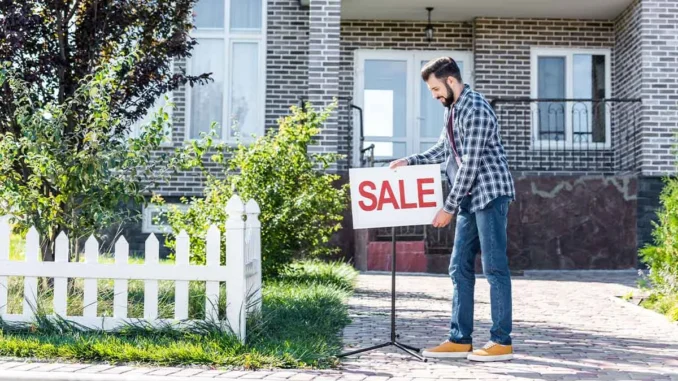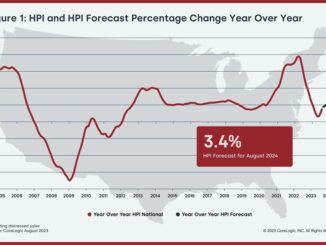
With elevated mortgage rates sidelining both home buyers and sellers, existing home sales fell in June, according to the latest report from the National Association of Realtors (NAR). Sales were also down significantly from a year prior.
Total existing home sales slipped 3.3% in June from the prior month to a seasonally adjusted annual rate of 4.16 million. Year-over-year, sales dropped 18.9% from 5.13 million in June 2022.
“The first half of the year was a downer for sure with sales lower by 23%,” said Lawrence Yun, NAR’s chief economist. “Fewer Americans were on the move despite the usual life-changing circumstances. The pent-up demand will surely be realized soon, especially if mortgage rates and inventory move favorably.”
The median existing-home price in June for all housing types – which includes single-family homes, condos and townhouses – was $410,200, the second-highest price of all time and down 0.9% from the record-high of $413,800 in June 2022. The monthly median price surpassed $400,000 for the third time, joining June 2022 and May 2022 ($408,600). Also noteworthy, prices rose in the Northeast and Midwest but waned in the South and West.
We’ve seen home sales drop on an annual basis since the Federal Reserve began hiking the benchmark rate in spring of 2022. Mortgage rates have settled into the 6% to 7% range over the last three months, depressing existing home sales.
Total housing inventory recorded at the end of June was 1.08 million units, unchanged from May, but down 13.6% from June 2022 (1.25 million). Meanwhile, unsold inventory sits at a 3.1-month supply at the current sales pace, up slightly from 3.0 months in May and 2.9 months in June 2022, NAR said.
“Home sales fell but home prices have held firm in most parts of the country,” NAR’s Yun added. “The national median home price in June was slightly less than the record high of nearly $414,000 in June of last year. Limited supply is still leading to multiple-offer situations, with one-third of homes getting sold above the list price in the latest month.”
Although all four regions experienced year-over-year sales declines, the Northeast fared better while the Midwest held steady, and the South and West posted decreases.
Zooming in on the Northeast, existing-home sales there grew 2.0% from May to an annual rate of 510,000 in June, down 21.5% from June 2022. The median price was $475,300, up 4.9% from the prior year. In the Midwest, existing-home sales remained unchanged from one month ago at an annual rate of 990,000 in June, decreasing 19.5% from one year ago. The median price there was $311,800, up 2.1% from June 2022. In the South, existing home sales disappointed as they faded 5.4% from May to an annual rate of 1.91 million in June, a decrease of 16.2% from the previous year. The median price was $366,600, down 1.2% from June 2022. Lastly, in the West, existing-home sales declined 5.1% from the previous month to an annual rate of 750,000 in June, down 22.7% from one year ago. The median price was $606,500, down 3.4% from the same period last year.
The good news is that the housing recession that was predicted by some economists has not materialized, noted Lisa Sturtevant, chief economist for Bright MLS.
”With positive inflation news and a strong labor market, the possibility that the Fed will be able to bring the economy in for a “soft landing” is improving. As the economy normalizes, however, we are still in the midst of a very unusual housing market, with so much inventory locked down as a result of the low pandemic mortgage rates,” said Bright MLS’s Sturtevant.
Properties in June on average remained on the market for 18 days, identical to May but up from 14 days in June 2022. Conversely, 76% of homes sold in June were on the market for less than a month. First-time buyers were responsible for just 27% of sales in June, down from 28% in May and 30% in June 2022, illustrating the affordability crisis at play.
For transaction types, all-cash sales accounted for 26% of purchases in June, up from 25% in both May 2023 and June 2022. Meanwhile, individual investors or second-home buyers, who make up many cash sales, purchased 18% of homes in June, up from 15% in May and 16% the previous year.
Distressed sales, which include foreclosures and short sales, represented only 2% of sales in June, virtually unchanged from last month and the prior year.
In this market, the lack supply remains the main constraint but new housing construction should help alleviate some of the supply pressures, according to Sturtevant. As a result, homebuilders kept capitalizing on a lack of competition and injected supply into the marketplace. However, inventory will still be sparse and prices “will have nowhere to go but up in the second half of 2023.”
“Existing home sales will continue to remain suppressed while both sides of this market are feeling the heat of affordability constraints, and we will likely continue to see buyers turning their eyes towards the new construction market – which can offer incentives to tip the scales in favor of buyers’ budgets as well as offer more available inventory,” added Nicole Bachaud, a senior economist at Zillow.



